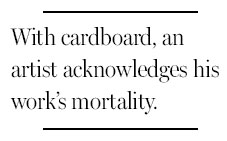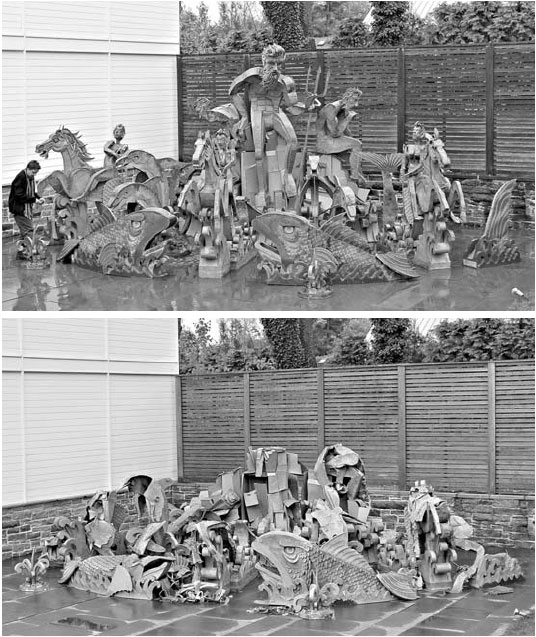Sculptures that were not meant to last
Updated: 2013-05-26 06:02
By William Grimes(The New York Times)
|
|||||||||
|
The undoing of James Grashow's "Corrugated Fountain" was intentional. It was placed outside in its original state, top, and is shown after six weeks. Photographs by Olympia Stone |
In December 2006 James Grashow, a sculptor and illustrator, went to Purchase, New York, to visit the family of Allan Stone, the art dealer who had recently died after representing him for four decades.
He got a big surprise.
There, on the lawn, two of his sculptures - giant papier-mache figures - were lashed like hostages to an oak tree. Other figures lay in a disintegrating heap, undone by wind and rain.
For 20 years the works had been on loan to Purchase College, which had returned them to Mr. Stone about six months earlier. Mr. Stone, a notoriously acquisitive collector, had no room left in his house for art, so he had put the work on the lawn.
Mr. Grashow was left reeling. "To see my dealer lump the work like a piece of garbage in the backyard was almost a verification of all the negative feelings that I've ever had about myself, my work, my own aspirations to do something great," he told Olympia Stone, a daughter of Mr. Stone's. The interview was for her film "The Cardboard Bernini," shown at the Art of Brooklyn Film Festival on May 18.
The film, five years in the making, is a documentary of the artist at work on "Corrugated Fountain," an assemblage of figures inspired by the Roman fountains of the Baroque sculptor Gian Lorenzo Bernini and animated by an insight that came to Mr. Grashow as he pondered the fate of his papier mache figures.
All art decays. Why not embark on a grand work that admits its own mortality, that embraces its own destruction? The ignominious end of his papier-mache figures was, Mr. Grashow decided, a blessing. "I was liberated, in a way, to be the architect of what was inevitable, anyway," he told Ms. Stone.
For three years Ms. Stone would fly in to watch the work evolve. Slowly the fountain emerged, a turbulent assemblage of rushing waves and dolphins, of nymphs, holding trumpets, astride rearing horses.
Cardboard might seem an unlikely medium, but not to Mr. Grashow. As a child in Brooklyn, he said, he impatiently discarded the wrapping on presents and threw himself at the boxes.
After earning an art degree from Pratt Institute in New York, he studied in Florence on a Fulbright grant, surrounded by masterpieces in marble. But a visit to the 1964 Venice Biennale, where he saw a giant hamburger by Claes Oldenburg, pushed him in a Pop direction.

His early work was whimsical, grotesque and obsessively detailed. As an illustrator, he worked for a variety of publications and for Columbia Records. He designed the cover for Jethro Tull's 1969 album, "Stand Up."
In time, corrugated board became his preferred medium. "It's so ephemeral," he said. "It's so grateful for the opportunity to become something, because it knows it's going to be trash," he said.
His more recent work includes the continuing series "Houseplants" - flowers that sprout meticulously rendered houses instead of pistils - the similarly small-scale "Cardbirds," and the large-scale "events," which he often completes with the help of volunteers.
In January he and a group of art students and faculty members at the University of Tulsa in Oklahoma made 26 giant letters for "Corrugated Alphabet."
In the same vein, he has executed brightly colored fish in "Under the Corrugated Sea," a colony of monkeys in "The Great Monkey Project" and, in "A City," an anthropomorphic Manhattan made up of humanized buildings wrapped in patterned fabric.
"Corrugated Fountain" made its debut, indoors, at the Taubman Museum of Art in Roanoke, Virginia, before landing at the Aldrich Contemporary Art Museum in Ridgefield, Connecticut, in April 2012. There, for the first time, it was exposed to the elements. Six weeks later, the remnants were collected and hauled away. But where?
"I swear I have no idea," Mr. Grashow said. "Probably to a landfill. Maybe I should have followed it and watched."
The New York Times
(China Daily 05/26/2013 page12)
